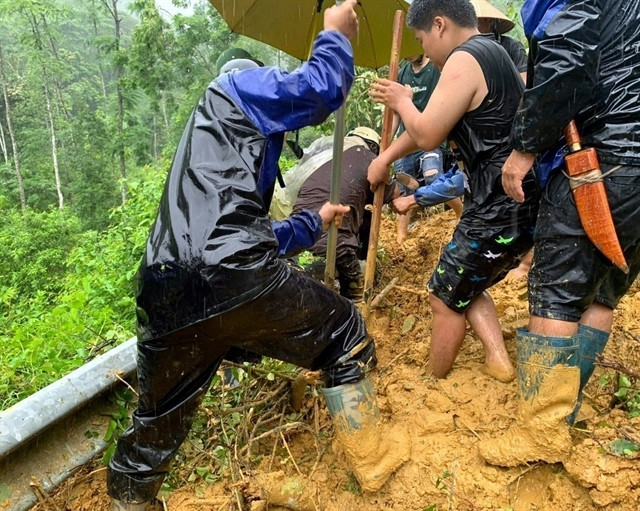 |
| A rescue team pulls a victim to safety from a landslide in Na Rì District, Bắc Kạn Province. — VNA/VNS Photo Nguyễn Công Hải |
Heavy rains and landslides over the past few days have wreaked havoc across northern Việt Nam, leaving a trail of destruction in their wake.
According to reports from northern provinces, the torrential downpours from July 29 to 30 have resulted in the tragic loss of six lives, with one person missing and two others injured.
The provinces have also experienced extensive damage to infrastructure, with 82 houses reported to be destroyed or damaged and a further 18 requiring urgent evacuation.
Agricultural lands have not been spared either, with more than 80 hectares of crops submerged in floodwaters.
Additionally, landslides have caused widespread traffic disruption, with 51 separate incidents reported, leading to the displacement of thousands of cubic metres of soil and rock.
In Lào Cai Province, heavy rains and flooding have caused the Red River to overflow, reaching its highest level this year. The rapidly rising waters have inundated crops along the riverbanks.
The water level is expected to continue to rise, peaking at 2pm on July 31 before gradually receding.
The meteorological agency forecasts even more severe weather for the region, with up to 200mm of rainwater expected in certain spots through August 1.
In response to the situation, local authorities have worked tirelessly to provide aid and support to the affected communities. Efforts are underway to relocate displaced residents, provide emergency shelter and distribute essential supplies.
The Ministry of Agriculture and Rural Development has called for measures to mitigate the impact of the recent earthquakes in Kon Plông District, Kon Tum Province and to prepare for potential future events.
The ministry has also sent an urgent directive to provinces and cities, as well as relevant ministries and agencies, regarding the prevention of casualties and active response to floods and landslides in the next few days.
Under the directive, they are urged to step up communication campaigns to keep people on high alert, strengthen disaster preparedness and enforce safety measures, including strictly controlling access to flood-hit areas.
They are also urged to enhance monitoring of weather conditions and provide timely updates to the public and assemble rescue teams and resources to be on standby for any potential incidents. — VNS